Or How I Had The Best Job In The World And Found That Stilt-Man Could Not See His Feet
Standard Disclaimer:
This collection of essays and memoirs are from my point of view. This is, to the best of my aging memory, what happened to me and around me. I intend to start with breathing life into the Marvel Comics Bullpen as I knew it. This is by definition, limiting. The Bullpen has been roaring along since the 1940s –as far as I know. Rubber cement pots, T-squares and White-Out have given way to “paper-less” offices with computers crowded into cubicles. The Bullpen is still barreling along. Me? I set foot there for a short period of time. I came to think of the Bullpen as a personality, not quite a person, not quite a service… perhaps a hive-mind or synthetic personality… no, maybe I went too far. The Bullpen is a character to me, still smelly and alive in memory.
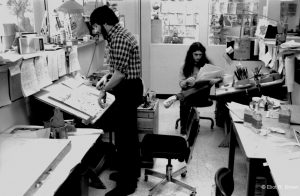
This will be an imprecise recollection. I have some pictures to help with ‘precision.’ I plan on talking about what I saw and did with my buddies. The time we shared was full of work, play and a harder to quantify joie de vivre.
I worked in comics. Which means all I know about comics is what I read as an amateur and read and worked on as a professional. By ‘professional’ I mean I got paid. This does not mean I know how to make a good/great/exceptional comic. First we might try to figure out what one of those are.
Try this guy. One has to admire the sheer determination of drawing a 270-page book that peels the layers apart, onion-like, of this peculiar visual medium. It’s not just a good read, it’s educational. I highly recommend Scott McCloud’s Understanding Comics. One of the things that separate “us” from “them” is our language. Comic pros speak a secret language. To help understand a little better, McCloud’s book is a good start.
Comic books usually contain multi-page stories with panel-to-panel continuity. The power of comics is that any story can be told in a comic format. The simplest personal moment to world-shattering.
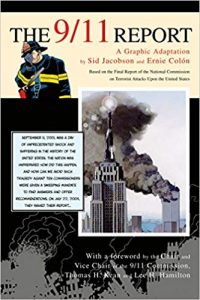
Sid Jacobsen, chum and former colleague along with legendary talent Ernie Colon did yeomanly duty making the official report understandable.
The simplest version of a comic I’ve seen are two black dots per white panel, speaking via word balloons. Works just fine. There’s at least one fully illustrated Bible. There were well-known and quite good comic books made for the military to show soldiers all sorts of maintenance procedures.
If you ask the average person what a comic book is, the answer could be either escapist material or super-heroes clashing or full-figured women in tight-fitting armor, etcetera. Content never used to matter because it was assumed it was formulaic. The comic book business has creaked with slow changes.
There are distinctions between types of illustrated stories. Comics or comic books we just talked about. Cartoons—in print form are gags. Usually a single panel. Such as appear in newspapers or The New Yorker Magazine. Newspaper strips or comic strips are only a short sequence of panel-to-panel story telling. Strip work is highly specialized and very difficult. The needs of the various strip syndicates are unrelenting and require a lot of organization and effort.
I’ve barely written a comic. My friend, Jack Morelli and I co-created and wrote the plot and, at the time, script for Spitfire And The Troubleshooters. This was during the you-hadda-be-there time of The New Universe. Spitfire wound up being a disappointment to me and Jack. Someone else was brought in to write the script, or what the characters said.
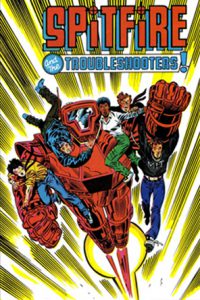
I have written lots of comic pages with stories on them, The Iron Manual and The Punisher Armory. I co-wrote the plot and script of The Cold War Of Nick Fury (a subset of Nick Fury Agent Of S.H.I.E.L.D.) but that was not quite a 50/50 split of work with my pal and partner, Bob Sharp. I do not particularly care for super-heroes—I know… a shocking admission. But my work speaks of that, Jenny Swensen, Tony Stark, Nick Fury and Frank Castle are mere people. Highly motivated mere people, but just people. I had pitches aimed at The Further Adventures Of Indiana Jones and Batman. Again, just people.
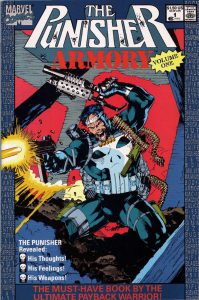
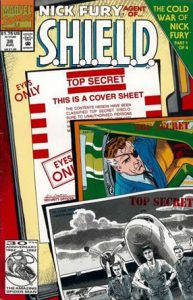
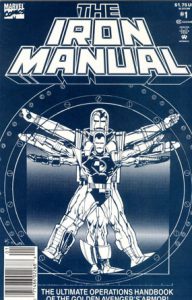
When someone does ask me what is my favorite comic book, I reply Amazing Spider-Man #31-32
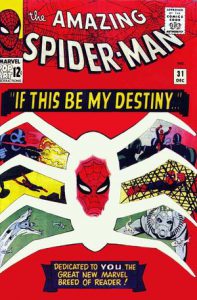
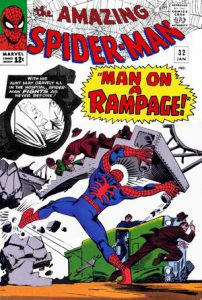
Apparently much of these two books was written and drawn flat-out by Steve Ditko with Stan doing the script and Artie Simek doing the kibitzing. What that meant was that Steve drove the book. The story has Spidey trapped in a sub-East River base belonging to Doc Ock (heady stuff for the young Eliot back in 1966). What is most amazing about this sequence—and this is over many pages, bridging the two books—is Spider-Man is pinned to the floor. That’s it, pinned down by a perfectly intersecting V of tons of steel. And he’s just thinking. There’s water rising, he tries to lift the thing and he is crunched back—on and on.
[Of note, in the glorious Taschen imprint, 75 Years Of Marvel, From The Golden Age To The Silver Screen, respected comic creator and historian – well, he’s a bit of that history as well, Roy Thomas – and nose-to-the-grindstone designer Josh Baker – also selected this sequence to celebrate. They reprinted 4 pages from this most extraordinary sequence on pgs. 364-365. I should point out that I am proud to have contributed some of the photos included in this enormous tome.
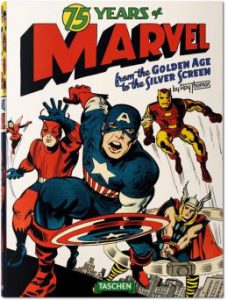
It’s a little pricey! But well worth the investment in a luscious and well-presented book. So big a project, only a blooded art-book editor (Maurene Goo) and crazy, high-end publisher, Taschen, which stands alone, could bring this to life.]
Chum and colleague, old comic pro, Tom DeFalco maintains that the short story is the closest thing in literature to a comic book. What separates the two mediums is the artwork, of course. Comics gives us a visual that when everything’s cooking just right, adds to the written portion. We can have it all, with pretty pictures and internal emotional stuff, mood—all.
Just to show I’m not an old fuddy-duddy in love with all things “Early Stan” I give up Alan Moore, Kevin O’Neill, Ben Dimagmilew & Bill Oakley’s The League Of Extraordinary Gentlemen as the finest example of modern (– eh, “Post-Modern”? What comes after “Silver Age” — Uranium? Formica?) comic creation, storytelling and art:
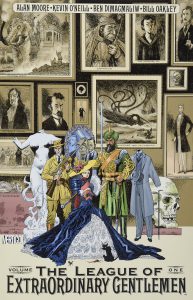
ISBN-10: 1563898586
ISBN-13: 978-1563898587
I like both the individual volumes in addition to the collected first volume, shown above. There’s enough differences to make it worth having all of the individual books. Moore’s credits are hilarious. The story foundation and execution is unalloyed genius. O’Neill’s artwork is quirky but solid, that’s what makes this such an artifact out of time and sets the mood. Lovely stuff.
Another frequent question I get is, “Is there a Marvel style? What is it?” One might as well ask, “What’s a rose? Is there a good one?” The idea of a Marvel Style is better defined by what it is not. It is hard to specify a clean brush line or figure out “spotting blacks.” This last is the balance of white and black areas throughout a page. But we know those when we see them. Using the finest practitioners of the comic art as a guide, we get Mike Kaluta doing Starstruck (or over at DC, The Shadow), Neal Adams on his Avengers stint, Barry Windsor-Smith or Marie Severin on anything or Bernie Wrightson’s Mary Wollstonecraft Shelley’s Frankenstein (alright… not a comic, but c’mon, it’s Bernie…). Four different guys, very different styles, degrees of stylization and story-telling but all at the height of the comic as art as well as commercial art.
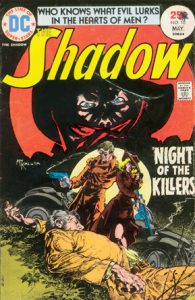
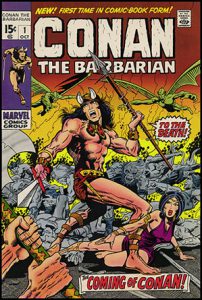
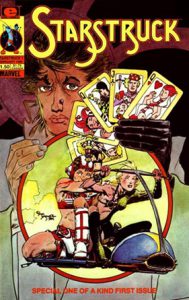
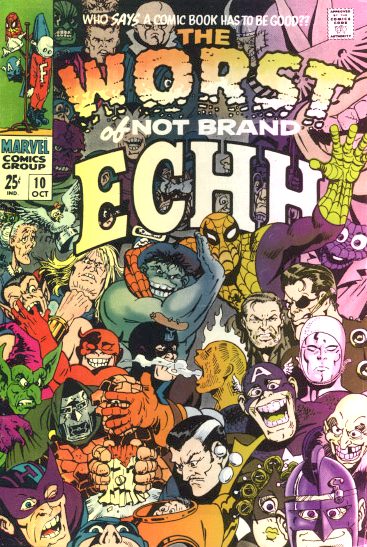
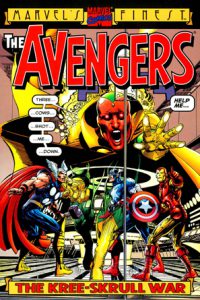
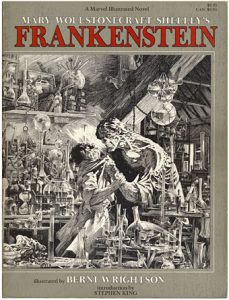
One thing to note about this bunch of extraordinary artists, is that they are complete artists. In that they pencil the books—telling much of the story in the process– and ink themselves. A rare event when inkers can improve on their pencils. In general, the story-telling part of penciling is more valuable than the “mere” inking, thus pencilers are paid more. But it is the inker who gets the last word. That black ink line is what is ultimately printed.
I think the use of the phrase “Marvel Style” is as much a brand statement as it is an artistic term. If you compare any batch of Marvel and DC Comics you will see much cross-fertilization. Which is mostly because everyone skips back and forth between the two. But there was a time when certain “old guard” artists, who had worked for decades, did so much work it was associated with either house.
But what of the “ham and eggers?” (A favorite sport’s expression, conveyed to me by Jack. It refers to a regular Joe, that came in, did that thing and went home.) This is not to ignore or make light of the middle-ground of comic artists and does not address the writing much at all. For every person mentioned above, there are 100 ham-and-egger practitioners of the art. I see them as… well… as the “salt of the comic Earths.” Without them, the rest of the comic universe had no foundation, no base to occasionally rise above.
My questioners usually take a dim view of my bringing up the subject of “commercial art.” Everybody’s doing this for money; art, good or bad, is a bonus. I would love to say we were in it as appreciators of the fine art of comics—and we mostly were. But we almost all of us lived in an expensive part of the world, New York City. I like to tell (and re-tell) my story about bringing a stack of old comics over to Con Ed’s (NYC’s electric utility, for those elsewhere) bill-paying office…
My time in comics was not a usual one. What sets me apart from the creators… the writers, pencilers, inkers, letterers and colorists is that I was on-staff for a long-ish time and wound up doing all of the above. I also took a lot of pictures… turned out I should have taken a lot more. Alas, I was a normally paid comic staffer and had to buy and process my own film.
My time in comics separates me from most run-of-the-mill comic readers as well. I was exposed to almost every aspect of making comics in my time, stat-camera operator, paste-up artist, art re-toucher, letterer and correction artist, typesetting computer operator, assistant editor, editor, creator, writer and back-biter! My purpose of writing this series of recollections is to pay tribute to the people who made comics every day. To try to tell of them and the things we did. With a few digressions along the way…
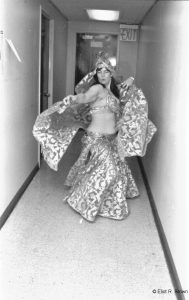
Paty Cockrum in full mufti, showing off a few belly-dancing moves at old 575 Madison Avenue…
Eliot R. Brown
Kingston, NY
2016
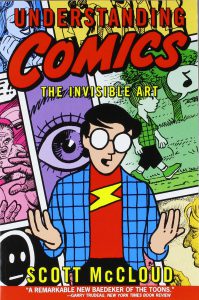
A hem…
Hey, Eliot… how come I don’t have copies of this???
You didn’t do any in color??? that was a pretty spectacular costume all in shades of yellow, orange and gold!!!
sigh… and I used it when I danced with Serena’s troupe at Lincoln Center in the late seventies or early eighties…
I’ve been sittin’ here for the past 6-7 years, hon! I’ll be in touch! Very glad to re-establish contact.
That period you worked at Marvel was, as you know, pretty special for the readers/fans who came of age at that time. In the pre-internet era, it was through your photos and projects like the Marvel Fumetti Book and Marvel Age (and of course Bullpen Bulletins) that it felt like we really got to “know” the denizens of the mighty Marvel bullpen, far beyond the writers and artists whose names were on every splash page. And I’m sure now that I’ve found your blog (you can thank a certain little stuffed bull), I’m going to rediscover even more. Thanks for sharing all these memories and for taking all those photos all those years, even if Marvel didn’t pay for your film and processing. 😁
I certainly think that time was a special time. It was a hotbed of projects and ideas, for sure. Your comment reminds me, I must get the collected Bulletins. I remember they were the day-to-day story– even if just tiny glimpses. And– you’re welcome~!
I found this blog years ago while looking up photo’s of Joe Simon. I kept following it because it gave me the “behind the scenes” of my childhood memories. Also Fran Grillo is my wife’s cousin so that article was a nice surprise. I even like your YouTube videos. You might dig some of my videos at Vnv125.
Thanks, bud! I wish I’d gotten to know Fran more while on staff– she was one of the rare execs that came downstairs. An indication of her openness and big heart. And, yeah, this is about as behind-the-scenes as your’e going to get!